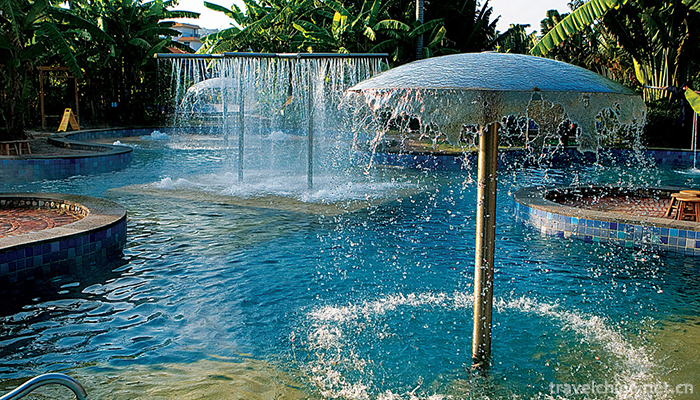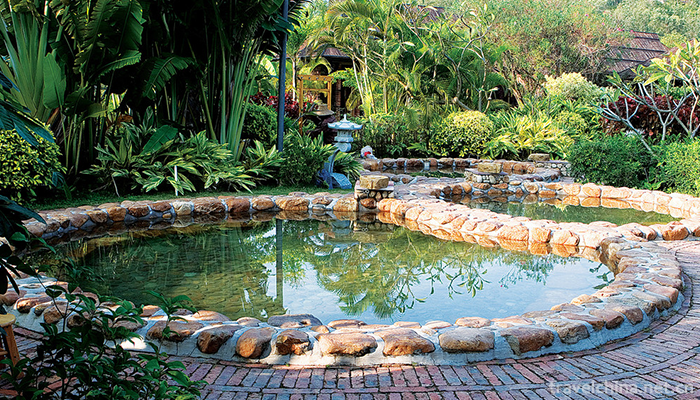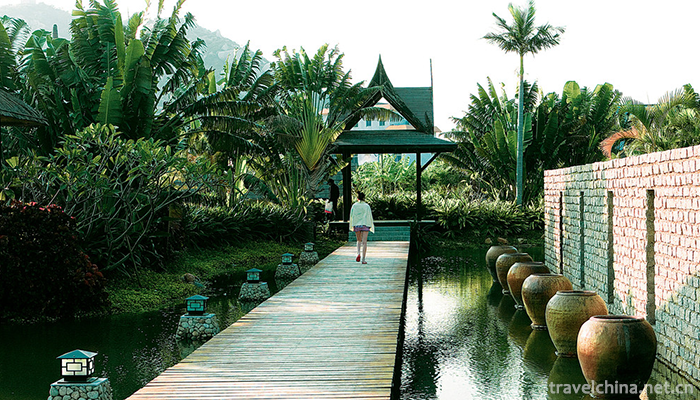Yushui Ancient Hot Spring
Maoming Yushui Ancient Hot Spring, under the Yuyi Shishan Mountain, beside the ancient post road, hot springs are all over the place. The water is boiling all the time. Officials in counties and cities, celebrities in distant places, admiring fame, gathering hot springs, singing poems and rewarding poems, traces of handwriting and ink are still in existence. This historical material describes the beauty of the human world, not elsewhere, but the ancient hot spring of Yushui in the hot water village of Magang Town, Dianbai District, Maoming City. Today, it has been built as a Paradise Resort - Yushui Ancient Hot Spring Resort.
Characteristics of scenic spots
Yushui Ancient Hot Spring is beside Guyi Road, but nowadays, we can no longer see the rugged and windy dust of Guyi Road. The traffic around the scenic spot is convenient. It is 28 kilometers away from Maoming City, Guangdong Province. It takes only 35 minutes to drive to Dianbai Yushui Ancient Hot Spring. The Spring area is adjacent to Guangzhou-Zhanjiang Expressway and 325 National Highway, and the traffic is very convenient. In Yushui Ancient Hot Spring, we can enjoy the beautiful wheels. The beauty of the immense rocks is only seen around the scenic spot surrounded by mountains, and the huge rocks on the mountains are magnificent, with different shapes.
In Yushui Ancient Hot Spring Resort, there are beautiful scenery in one flower, one grass, one pool and one pavilion. This resort is built according to AAAA grade scenic spot and four star hotel standard. It is one of the largest, the highest grade, the most complete functions, the most standardized management and the most thoughtful service hot spring cultural tourism resorts in Maoming area. Holiday Village integrates hot springs, tourism, catering, accommodation, conference training, leisure and entertainment projects, with more than 200 rooms, comfortable, luxurious, spacious and bright. Each of the South Asian style buildings and villas has an independent hot spring pool, allowing visitors to find themselves in the secret space of green and quiet.
The resort has 43 spa pools with different shapes and functions, which are distributed in the shade of green trees. Hot spring bath, hot spring surfing, hot spring SPA, hot spring fish therapy, hot spring magnetic sand, health care, dry and wet steaming, water development and other projects are all available.
The resort has an outdoor outdoor development training base which integrates exploration, crossing, caving, landing and tracing. Through carefully designed activities, tourists can be inspired by various kinds of activities, so as to achieve the purpose of tempering their will, tapping their potential, cultivating their sentiments, improving their personality and smelting their team.
At the same time, the delicacies of Yushui Ancient Hot Spring Resort are also praised by tourists. The restaurant here is full of farm style, full of local flavor, authentic green dishes, unique local characteristics of farm stir-fries and various functions of health packages, warm and thoughtful service, so that visitors can enjoy delicious food. The multi-functional international conference center can accommodate more than 300 people seated at the same time, with luxurious decoration, advanced equipment and complete functions. It is an ideal place for holding various business meetings and conference training. In addition, the resort's supporting facilities include luxury KTV boxes, health massage centers, chess and card rooms, sports courts, barbecue venues, specialty shopping malls and other supporting equipment.
A hot spring can move tourists, the biggest bright spot is the quality of hot springs. And the most commendable of the ancient Yushui hot springs is the quality of their hot springs. Its hot spring water temperature is as high as 82 degrees, water quality is rich in silicon, sulfur, fluorine and other mineral elements beneficial to human health, and the health function is excellent. In ancient times, county officials and distant celebrities all admired the name so far and kept their minds in good health. Huo Weinao, the chief soldier of Kangxi in Qing Dynasty and the first prize in Yanjing, once praised it with his magnificent scenery. It can be seen that the quality of hot springs here has been well known for a long time. Now, Yushui Ancient Hot Spring, which has been built with huge investment, has just opened to welcome visitors. It has gained unanimous praise from tourists for its mountain-building, green feeling and elegant pavilions.
In Caiyun Valley, you can slow down your pace, with a leisurely pace, measure the quiet mood, measure the calmness of the years, you quietly, with the passage of time walking forward. Come here and you will know what peace is. Come here and you will know what happiness is. In today's fashion-laden world, its quiet charm and calm power are even more evident here. Landscape, only when it is in harmony with the mood, can it radiate intoxicating brilliance and send out a shocking halo.
The warm fragrance of hot springs is refreshing. In some big cities, the exhaust of cars is breathed, the turbid air is breathed, and the tense and noisy atmosphere is breathed. Here, the breath is elegant fragrance, the breath is warm and fresh air. For the first time, people living here are living in paradise.
Here, when you crouch in the hot spring pool, in the mist, enjoy the rare quiet nature, body and mind, will be thoroughly released!
Yushui Ancient Hot Spring belongs to 100% pure natural hot springs. The outlet water temperature is between 80 and 82 degrees Celsius. The amount of hot springs'sunrise water reaches 8000 square meters. It can be said that there are endless sources and it belongs to the most productive hot spring resources found in Western Guangdong. Yushui Ancient Hot Spring Resort is located in the South China Geological Fault Zone, forming 100% natural spring. It belongs to the neutral hot springs of sedimentary rocks. The water quality contains radon, fluorine, radium, metasilicic acid and other trace mineral elements which are beneficial to human health. It has considerable medical value. With rich mineral content, mild water quality and abundant reserves, Yushui ancient hot spring has become one of the fifteen top quality health-care hot springs in Guangdong Province.
Tourism Information
Shenzhen (Dongguan) to Yushui Ancient Hot Spring:
Guangzhou-Shenzhen Expressway-Humen Bridge-Beijing-Zhuhai Expressway-Zhongjiang Expressway-Fokai Expressway-Kaiyang Expressway-Maozhang Expressway (Lintou Exit) 12 kilometers away from Yushui Ancient Hot Spring
Guangzhou (Foshan) to Yushui Ancient Hot Spring:
Fokai Expressway-Kaiyang Expressway-Maozhang Expressway (Lintou Exit) 12 km from Yushui Ancient Hot Spring
Ancient hot springs from Maoming to Yushui:
Mao-Zhan Expressway to Guangzhou (Lintou Exit) to Yushuigu Hot Spring 12 kilometers (by bus: get off at Maoming Bus Station at Maoming Bus Station to Diaocheng or Lingmen Bus-Magang Station)
Ancient hot springs from Zhanjiang to Yushui:
Mao-Zhan Expressway to Guangzhou (Lintou Exit) to Yushui Ancient Hot Spring 12 km





0 Questions
Ask a Question
Your email address will not be published.